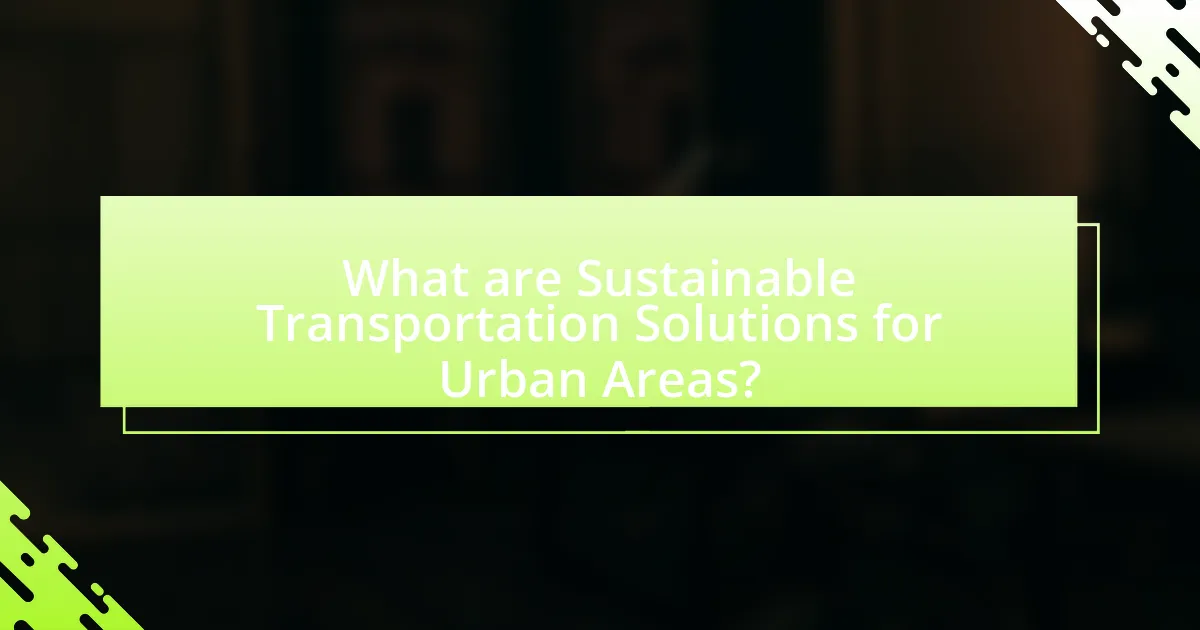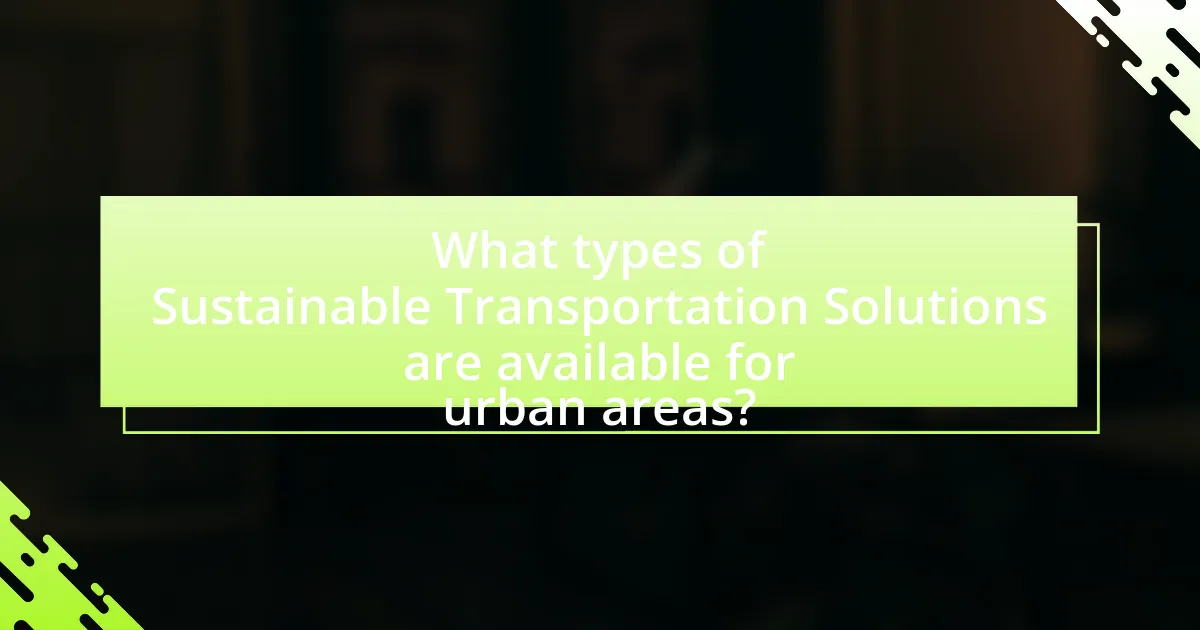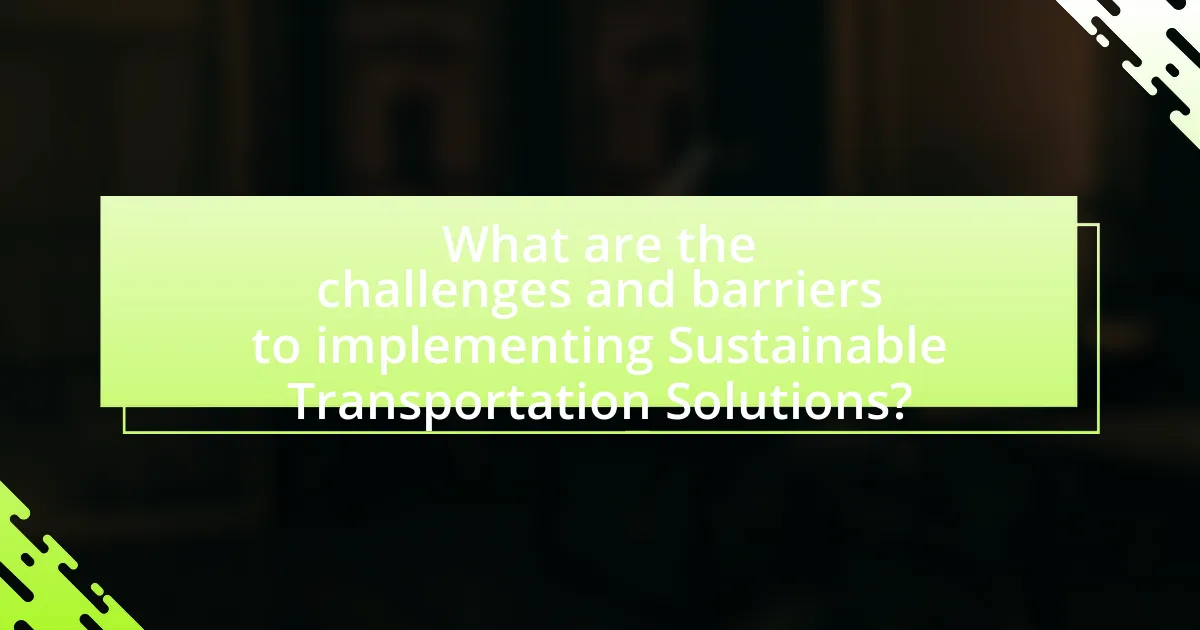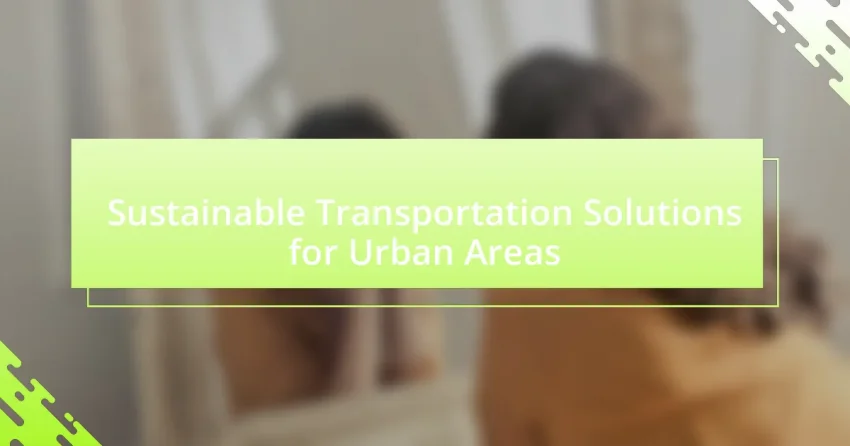Sustainable transportation solutions for urban areas encompass a range of initiatives aimed at reducing environmental impact and enhancing urban livability. Key components include public transit systems, cycling infrastructure, pedestrian-friendly designs, and electric vehicle initiatives, all of which contribute to lower greenhouse gas emissions and improved air quality. The article explores how these solutions differ from traditional transportation methods, their key characteristics, and the importance of sustainability in urban transportation. It also addresses the challenges and barriers to implementation, the role of infrastructure, and future trends in sustainable urban mobility, highlighting the significance of community engagement and technological advancements in promoting effective transportation strategies.

What are Sustainable Transportation Solutions for Urban Areas?
Sustainable transportation solutions for urban areas include public transit systems, cycling infrastructure, pedestrian-friendly designs, and electric vehicle (EV) initiatives. Public transit systems, such as buses and trains, reduce individual car usage, leading to lower greenhouse gas emissions; for example, a study by the American Public Transportation Association found that public transit saves 45 million metric tons of CO2 annually. Cycling infrastructure, including dedicated bike lanes and bike-sharing programs, promotes cycling as a viable alternative to driving, which can decrease traffic congestion and improve air quality. Pedestrian-friendly designs, such as wider sidewalks and safe crossings, encourage walking, enhancing urban livability. Additionally, EV initiatives, supported by charging stations and incentives, facilitate the transition to cleaner vehicles, contributing to reduced urban pollution levels. These solutions collectively aim to create more sustainable, efficient, and healthier urban environments.
How do Sustainable Transportation Solutions differ from traditional transportation methods?
Sustainable transportation solutions differ from traditional transportation methods primarily by prioritizing environmental impact and resource efficiency. Traditional transportation often relies on fossil fuels, contributing to greenhouse gas emissions and air pollution, while sustainable solutions utilize renewable energy sources, such as electric vehicles and public transit systems, which significantly reduce carbon footprints. For instance, electric buses can reduce emissions by up to 70% compared to diesel buses, as reported by the American Public Transportation Association. Additionally, sustainable methods emphasize multimodal transport options, promoting walking, cycling, and public transit, which enhances urban mobility and reduces traffic congestion. This shift not only addresses climate change but also improves public health and urban livability.
What are the key characteristics of Sustainable Transportation Solutions?
Sustainable transportation solutions are characterized by their ability to reduce environmental impact, enhance social equity, and promote economic viability. These solutions prioritize low-emission and energy-efficient modes of transport, such as public transit, cycling, and walking, which collectively contribute to decreased greenhouse gas emissions. For instance, cities that invest in electric buses and bike-sharing programs have reported significant reductions in air pollution and traffic congestion. Additionally, sustainable transportation emphasizes accessibility, ensuring that all community members, regardless of socioeconomic status, can access essential services and employment opportunities. This approach not only fosters inclusivity but also stimulates local economies by improving mobility. Furthermore, sustainable transportation solutions often incorporate smart technologies, such as real-time data for public transit, which optimize routes and reduce wait times, enhancing user experience and efficiency.
Why is sustainability important in urban transportation?
Sustainability is important in urban transportation because it reduces environmental impact and enhances quality of life. Sustainable urban transportation systems minimize greenhouse gas emissions, which contribute to climate change; for instance, transportation accounts for approximately 29% of total greenhouse gas emissions in the United States. Additionally, sustainable practices promote public health by reducing air pollution and encouraging active transportation modes like walking and cycling. Cities that invest in sustainable transportation infrastructure, such as public transit and bike lanes, often experience increased economic activity and improved accessibility, leading to more vibrant urban communities.
What are the main goals of implementing Sustainable Transportation Solutions?
The main goals of implementing Sustainable Transportation Solutions are to reduce greenhouse gas emissions, enhance energy efficiency, and improve public health. These solutions aim to create a more efficient transportation system that minimizes environmental impact while promoting the use of renewable energy sources. For instance, transitioning to electric public transport can significantly lower carbon emissions, as electric buses produce zero tailpipe emissions compared to traditional diesel buses. Additionally, promoting active transportation modes, such as walking and cycling, contributes to better air quality and public health outcomes by reducing reliance on fossil fuels and encouraging physical activity.
How do these solutions contribute to reducing carbon emissions?
Sustainable transportation solutions for urban areas contribute to reducing carbon emissions by promoting the use of low-emission vehicles, public transit, and active transportation methods like walking and cycling. These solutions decrease reliance on fossil fuels, which are a primary source of greenhouse gas emissions. For instance, electric buses can reduce emissions by up to 70% compared to traditional diesel buses, as reported by the American Public Transportation Association. Additionally, enhancing public transit systems can lead to a significant reduction in the number of single-occupancy vehicles on the road, further lowering overall emissions. According to the Environmental Protection Agency, public transportation can save approximately 45 million metric tons of carbon dioxide annually.
What role do Sustainable Transportation Solutions play in enhancing urban mobility?
Sustainable Transportation Solutions significantly enhance urban mobility by reducing traffic congestion and lowering greenhouse gas emissions. These solutions, such as public transit systems, cycling infrastructure, and pedestrian-friendly designs, promote efficient movement within cities. For instance, cities that invest in comprehensive public transportation networks can reduce the number of single-occupancy vehicles on the road, leading to a decrease in traffic jams and improved air quality. According to a study by the American Public Transportation Association, public transit use can reduce individual carbon footprints by up to 45%. Thus, implementing sustainable transportation options not only facilitates smoother urban mobility but also contributes to environmental sustainability.

What types of Sustainable Transportation Solutions are available for urban areas?
Sustainable transportation solutions available for urban areas include public transit systems, cycling infrastructure, pedestrian-friendly designs, electric vehicles, and car-sharing programs. Public transit systems, such as buses and trains, reduce individual car usage and lower emissions; for example, cities like New York and London have extensive subway networks that significantly decrease traffic congestion. Cycling infrastructure, including dedicated bike lanes and bike-sharing programs, promotes cycling as a viable alternative to driving, as seen in cities like Amsterdam, where cycling accounts for 27% of all trips. Pedestrian-friendly designs enhance walkability, encouraging people to walk instead of drive, which is evident in urban areas that prioritize mixed-use developments. Electric vehicles contribute to sustainability by reducing greenhouse gas emissions, with cities like San Francisco incentivizing their use through charging stations and rebates. Car-sharing programs, such as Zipcar, provide access to vehicles without ownership, reducing the number of cars on the road and promoting efficient use of resources.
How do public transportation systems contribute to sustainability?
Public transportation systems contribute to sustainability by reducing greenhouse gas emissions and minimizing urban congestion. These systems, such as buses and trains, can transport a large number of passengers simultaneously, leading to fewer individual vehicles on the road. For instance, the American Public Transportation Association reports that public transit saves approximately 45 million metric tons of carbon dioxide annually, equivalent to the emissions from 9.5 million cars. Additionally, public transportation encourages compact urban development, which reduces the need for extensive road infrastructure and promotes energy efficiency. By providing an alternative to personal vehicles, public transportation systems play a crucial role in fostering environmentally friendly urban environments.
What are the benefits of electric buses and trains?
Electric buses and trains offer significant benefits, including reduced greenhouse gas emissions, lower operating costs, and improved air quality. These electric vehicles produce zero tailpipe emissions, which contributes to a decrease in urban air pollution and aligns with climate goals. According to the International Energy Agency, electric buses can reduce emissions by up to 70% compared to diesel buses. Additionally, electric buses and trains have lower maintenance costs due to fewer moving parts and can be powered by renewable energy sources, further enhancing their sustainability. Studies show that cities adopting electric public transport systems experience improved public health outcomes and increased ridership, demonstrating their effectiveness as a sustainable transportation solution.
How can bike-sharing programs promote sustainable urban transport?
Bike-sharing programs promote sustainable urban transport by providing an accessible and eco-friendly alternative to motorized vehicles. These programs reduce traffic congestion and lower greenhouse gas emissions, as studies indicate that bike-sharing can replace short car trips, which account for a significant portion of urban traffic. For instance, a study by the Institute for Transportation and Development Policy found that bike-sharing systems can reduce carbon emissions by up to 10% in urban areas. Additionally, bike-sharing encourages active transportation, improving public health and reducing reliance on fossil fuels, further contributing to sustainability goals in urban environments.
What role does infrastructure play in Sustainable Transportation Solutions?
Infrastructure is crucial for Sustainable Transportation Solutions as it provides the necessary framework for efficient, eco-friendly transit systems. Well-designed infrastructure, such as dedicated bike lanes, electric vehicle charging stations, and efficient public transit networks, facilitates the use of sustainable modes of transport, reducing reliance on fossil fuels. For instance, cities that invest in comprehensive public transportation systems can decrease greenhouse gas emissions by up to 45% compared to car-dependent urban areas, as evidenced by studies from the American Public Transportation Association. This demonstrates that effective infrastructure not only supports sustainable transportation but also contributes significantly to environmental goals.
How do dedicated bike lanes and pedestrian pathways enhance sustainability?
Dedicated bike lanes and pedestrian pathways enhance sustainability by promoting non-motorized transportation, which reduces greenhouse gas emissions and traffic congestion. These infrastructure elements encourage cycling and walking, leading to a decrease in reliance on cars. For instance, cities that have implemented extensive bike lane networks, such as Copenhagen, have seen a 62% reduction in carbon emissions from transportation since 1995. Additionally, dedicated pathways improve safety for cyclists and pedestrians, further incentivizing their use and contributing to healthier urban environments. Studies indicate that increased cycling and walking can lead to a 30% reduction in urban traffic, thereby enhancing air quality and reducing noise pollution.
What are the challenges of retrofitting existing infrastructure for sustainability?
Retrofitting existing infrastructure for sustainability faces several challenges, including financial constraints, technical limitations, and regulatory hurdles. Financially, the costs associated with upgrading infrastructure can be prohibitive, as studies indicate that retrofitting can require significant investment, often exceeding initial construction costs. Technically, existing structures may not be designed to accommodate new sustainable technologies, leading to complications in integration. Additionally, regulatory frameworks may not support innovative changes, as outdated codes and standards can impede the adoption of sustainable practices. These challenges collectively hinder the effective implementation of sustainable transportation solutions in urban areas.

What are the challenges and barriers to implementing Sustainable Transportation Solutions?
The challenges and barriers to implementing Sustainable Transportation Solutions include high initial costs, lack of political will, insufficient infrastructure, and public resistance. High initial costs deter investment in sustainable technologies, as seen in electric vehicle infrastructure, which requires significant funding for charging stations. Lack of political will often results in inadequate policy support, hindering the adoption of sustainable practices. Insufficient infrastructure, such as bike lanes and public transit systems, limits accessibility and convenience for users. Public resistance can stem from a lack of awareness or perceived inconvenience, which has been documented in various urban studies indicating that community engagement is crucial for successful implementation.
What financial obstacles do cities face in adopting these solutions?
Cities face significant financial obstacles in adopting sustainable transportation solutions, primarily due to high initial capital costs and ongoing maintenance expenses. For instance, implementing electric bus fleets or extensive cycling infrastructure requires substantial upfront investment, which many municipalities struggle to allocate from their budgets. Additionally, cities often encounter funding limitations from state and federal sources, as grants for sustainable projects may be competitive and insufficient to cover all necessary expenses. According to a report by the American Public Transportation Association, public transit agencies face a funding gap of approximately $89 billion over the next decade, highlighting the financial strain on urban areas seeking to transition to sustainable transportation.
How can funding and investment be secured for sustainable projects?
Funding and investment for sustainable projects can be secured through a combination of public-private partnerships, grants, and impact investing. Public-private partnerships leverage resources and expertise from both sectors, facilitating the development of sustainable transportation solutions. For instance, the U.S. Department of Transportation has allocated billions in grants to support innovative projects that enhance urban mobility while reducing environmental impact. Additionally, impact investing focuses on generating social and environmental benefits alongside financial returns, attracting investors interested in sustainability. According to the Global Impact Investing Network, the impact investing market reached $715 billion in 2020, indicating a growing interest in funding sustainable initiatives.
What are the political and regulatory challenges involved?
Political and regulatory challenges in sustainable transportation solutions for urban areas include the need for comprehensive policy frameworks, funding allocation, and inter-agency coordination. Policymakers often face resistance from various stakeholders, including automotive industries and local communities, which can hinder the implementation of new regulations. For instance, the lack of standardized regulations across different jurisdictions can create confusion and inefficiencies, as seen in cities that have struggled to integrate electric vehicle infrastructure due to varying local laws. Additionally, funding for sustainable projects is often limited, requiring political will to prioritize these initiatives over traditional transportation funding. These challenges are compounded by the need for public support and engagement, which is crucial for the successful adoption of sustainable practices.
How can public perception and behavior impact the success of Sustainable Transportation Solutions?
Public perception and behavior significantly impact the success of Sustainable Transportation Solutions by influencing adoption rates and usage patterns. When the public views sustainable transportation options, such as electric buses or bike-sharing programs, positively, they are more likely to utilize these services, leading to increased demand and investment. For instance, a study by the Transportation Research Board found that cities with strong public support for sustainable initiatives saw a 30% higher usage rate of public transit options compared to those with negative perceptions. Additionally, community engagement and awareness campaigns can shift public attitudes, fostering a culture of sustainability that encourages individuals to choose eco-friendly transportation methods. This collective behavior not only enhances the viability of sustainable solutions but also contributes to broader environmental goals, such as reducing carbon emissions and traffic congestion.
What strategies can be used to encourage public adoption of sustainable practices?
To encourage public adoption of sustainable practices, strategies such as education, incentives, and community engagement can be effectively implemented. Education initiatives, like workshops and informational campaigns, raise awareness about the benefits of sustainable practices, leading to informed decision-making among the public. For instance, studies show that communities with educational programs on sustainability see a 30% increase in participation in eco-friendly activities.
Incentives, such as tax breaks or subsidies for using public transportation or purchasing electric vehicles, motivate individuals to adopt sustainable behaviors. Research indicates that financial incentives can increase the adoption rate of electric vehicles by up to 50%.
Community engagement through local events and partnerships with organizations fosters a sense of ownership and responsibility towards sustainable practices. Evidence from urban areas that host sustainability fairs demonstrates a significant rise in community-led initiatives, with participation rates increasing by 40% after such events.
These strategies collectively create an environment conducive to the public’s adoption of sustainable practices, leading to long-term behavioral change.
How does community engagement influence transportation planning?
Community engagement significantly influences transportation planning by ensuring that the needs and preferences of local residents are integrated into the decision-making process. When communities actively participate, planners can gather valuable insights about traffic patterns, safety concerns, and accessibility issues that may not be evident through data alone. For instance, studies have shown that projects with strong community involvement tend to have higher rates of public acceptance and usage, leading to more effective and sustainable transportation solutions. Engaging with the community also fosters transparency and trust, which can result in better collaboration between stakeholders and ultimately lead to more successful transportation initiatives.
What best practices can cities adopt to enhance Sustainable Transportation Solutions?
Cities can enhance Sustainable Transportation Solutions by implementing integrated public transit systems that prioritize accessibility and efficiency. For instance, cities like Copenhagen have successfully integrated cycling infrastructure with public transport, resulting in a 62% cycling rate among residents. Additionally, cities should promote electric vehicle (EV) adoption through incentives and charging infrastructure, as seen in Oslo, where EVs accounted for 54% of new car sales in 2020. Furthermore, implementing congestion pricing can reduce traffic and encourage the use of public transport, as demonstrated by London’s congestion charge, which led to a 30% decrease in traffic congestion since its introduction. These practices collectively contribute to reduced emissions and improved urban mobility.
How can cities effectively integrate multiple modes of transportation?
Cities can effectively integrate multiple modes of transportation by developing comprehensive transit networks that prioritize connectivity, accessibility, and user experience. This integration involves creating multimodal hubs where different transportation options, such as buses, trains, bicycles, and pedestrian pathways, converge, allowing seamless transfers between them. For instance, cities like Amsterdam and Copenhagen have successfully implemented extensive cycling infrastructure alongside public transit systems, resulting in increased ridership and reduced traffic congestion. Studies show that cities with integrated transportation systems can reduce travel times by up to 30%, enhancing overall urban mobility and sustainability.
What role does technology play in improving urban transportation sustainability?
Technology plays a crucial role in improving urban transportation sustainability by enabling efficient resource management and reducing emissions. Smart traffic management systems, such as adaptive signal control technology, optimize traffic flow, which decreases congestion and lowers fuel consumption. Additionally, electric and hybrid vehicles, supported by advancements in battery technology, significantly reduce greenhouse gas emissions compared to traditional combustion engines. According to the International Energy Agency, electric vehicles can reduce emissions by up to 70% over their lifetime compared to gasoline vehicles. Furthermore, data analytics and mobile applications enhance public transportation accessibility and efficiency, encouraging more people to use these sustainable options. These technological innovations collectively contribute to a more sustainable urban transportation ecosystem.
What are the future trends in Sustainable Transportation Solutions for urban areas?
Future trends in sustainable transportation solutions for urban areas include the widespread adoption of electric vehicles (EVs), increased investment in public transit systems, and the integration of smart mobility technologies. Electric vehicles are projected to dominate urban transportation, with global sales expected to reach 30% of total vehicle sales by 2030, driven by advancements in battery technology and government incentives. Public transit systems are being enhanced through the implementation of dedicated bus lanes and light rail expansions, which can reduce congestion and emissions. Additionally, smart mobility technologies, such as ride-sharing platforms and mobility-as-a-service (MaaS) applications, are facilitating seamless transportation options, promoting the use of shared resources and reducing reliance on personal vehicles. These trends are supported by urban planning initiatives aimed at creating more walkable and bike-friendly environments, ultimately contributing to lower carbon footprints in cities.
How might autonomous vehicles impact urban transportation sustainability?
Autonomous vehicles may significantly enhance urban transportation sustainability by reducing traffic congestion and lowering greenhouse gas emissions. Studies indicate that the widespread adoption of autonomous vehicles could lead to a 60% reduction in traffic accidents, which would decrease the need for extensive road infrastructure and maintenance. Furthermore, research from the International Transport Forum suggests that autonomous vehicles can optimize traffic flow, leading to a potential 20-30% decrease in fuel consumption. This efficiency not only conserves energy but also contributes to improved air quality in urban environments.
What innovations are on the horizon for sustainable urban mobility?
Innovations on the horizon for sustainable urban mobility include electric and autonomous vehicles, smart public transportation systems, and integrated mobility platforms. Electric vehicles are projected to reduce greenhouse gas emissions significantly, with studies indicating that they can lower emissions by up to 70% compared to traditional gasoline vehicles. Autonomous vehicles are expected to enhance traffic efficiency and safety, potentially decreasing accidents by 90% according to the National Highway Traffic Safety Administration. Smart public transportation systems, utilizing real-time data and AI, can optimize routes and schedules, improving user experience and reducing congestion. Integrated mobility platforms, which combine various transportation modes into a single accessible service, are anticipated to streamline urban travel, making it more efficient and environmentally friendly.
